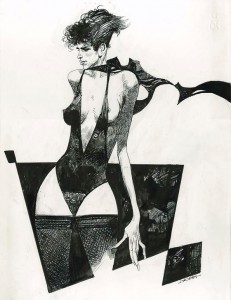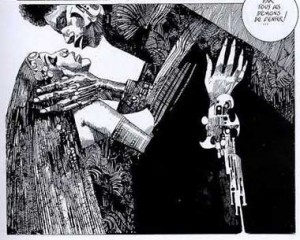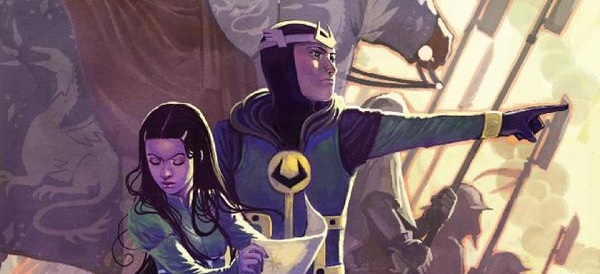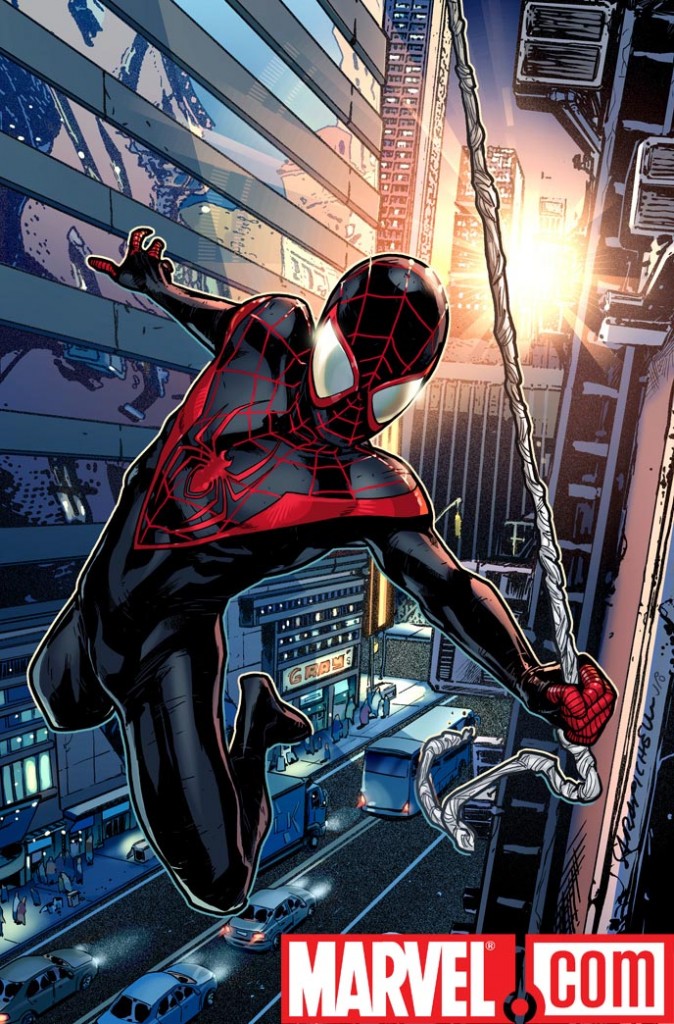
This week’s Comic Revolt looks back at the work and influence of legendary comic artist and illustrator, Sergio Toppi, who sadly passed away earlier this week.
I knew little of Toppi until his recent passing, hearing his name whenever Moebius or another European comic creator was being discussed, but did a little bit of digging after hearing a steady flow of lamentation on his work and life passed through the chatter of social media. Perhaps it was time for me to take a deeper look at a man many people consider one of the true masters.
While not nearly as popular as European contemporary Moebius, Toppi quietly influenced generations of artists ranging from Walt Simonson to Ashley Wood. Like many great Italian artists, Toppi exhibited amazing technical ability in his use of negative space and draftmanship, but emphasizing his technical gifts without consideration of his other amazing skills doesn’t truly cut to the core of what made him an artist as opposed to someone who could draw.
 Retrospectives tend to have a rather vacuous level of qualification in the case of art. Having said that, looking at Toppi’s work conveys a great deal in terms of artistry and connectivity to art’s place in the world of the living. The man’s work tells a story with each image.
Retrospectives tend to have a rather vacuous level of qualification in the case of art. Having said that, looking at Toppi’s work conveys a great deal in terms of artistry and connectivity to art’s place in the world of the living. The man’s work tells a story with each image.
His ability to tell stories through sequential art was not only revolutionary, but remains revolutionary beyond his death. He understood how each panel was an opportunity to tap into the fourth dimension of time and create a liquid sort of movement or flow that can carry a story from start to finish.
He got his start in the world of art in the 1950s doing illustration and advertising, but made his debut in comics in 1966. During this time, he was drawing comics that were quite different in comparison to super hero fueled comics being made in America.
Toppi’s technical precision worked as a great scaffold for one of his greatest talents as an artist – to capture the emotion and inner life of the characters and world they inhabited. This ability to capture the story within the story may be the biggest difference between him and the American school of artists at the time.
Consider his level of attention to eyes, gestures, and expression. As much as I appreciate the greats in American comics at the time, none came close to his ability to find the inner life of his characters. His work had less to do with the heavy kinetics of someone like Jack Kirby and more to do with capturing a timeless, extemporal feel for the moment.
 For much of his career, Toppi made a modest living creating his amazing art without receiving the fanfare that most people associate with comic book artists. However, his work consistently made its ways into the hands of artists in search of greatness.
For much of his career, Toppi made a modest living creating his amazing art without receiving the fanfare that most people associate with comic book artists. However, his work consistently made its ways into the hands of artists in search of greatness.
Here’s an excerpt from the Italian art magazine Ultrazine written by Walt Simonson about his first experience with Toppi’s work:
“Back in the mid-1970’s, there were comics conventions held in New York City once or twice a year. I was a young professional then and since I was living in New York, I attended the conventions regularly… Mostly, such conventions were a place to socialize, to see old friends who’d come to town, and to meet professionals I didn’t know whose work I admired. But there was the rare table–actually there was only one or maybe two such tables–where one could find graphic novels. Not just graphic novels but European graphic novels. It was work I knew very little about back then and almost never had a chance to see. The table was filled with books drawn by artists I’d never heard of, imagery I’d never imagined. And one of the first books that caught my eye was a volume entitle ‘L’homme des Marais’ by some guy named Sergio Toppi. I didn’t know the name but he was clearly major.”
Through the years, more and more people would become familiar with this master’s work and the legend grew, even if it’s was on a by word of mouth basis. If you were to take a straw poll of every working artist in comics today, there’s a good chance they know Sergio Toppi’s work.
The outpour of tributes from Twitter after his passing speaks volumes. Artist Jim Lee tweeted, ” RIP Sergio Toppi–il maestro grande. Every line brought forth the true nature of his subject. A huge “secret” influence on so many US artists.”
I started this column a few weeks ago in an effort to shine a light on amazing talent in comics changing or revolutionizing the way comics are made. Toppi did that and more. His work is transcendent and elevated sequential storytelling in ways that will continue to influence and raise the bar for artistry.
 A great introduction to his work is the French edition of Le Collectionneur, Integrale, which will run you close to $100, but is well worth the investment. His work is something that writers and artists can get something from. Whether it’s a lesson in sequential storytelling or an example of capturing intangible excellence, Toppi’s artistry will be a reminder to future generations of where the bar has been set.
A great introduction to his work is the French edition of Le Collectionneur, Integrale, which will run you close to $100, but is well worth the investment. His work is something that writers and artists can get something from. Whether it’s a lesson in sequential storytelling or an example of capturing intangible excellence, Toppi’s artistry will be a reminder to future generations of where the bar has been set.













